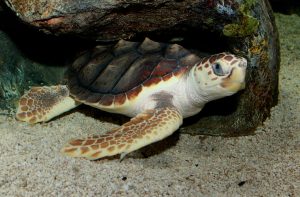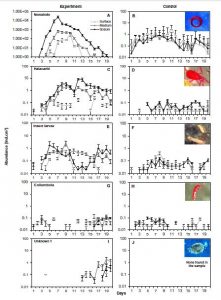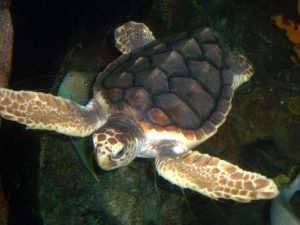The response of sandy beach meiofauna to nutrients from sea turtle eggs
By Abby Tinari, SRC intern
South African scientists, Diane et. al (2017), studied how organic matter is transferred through the food web and how this influences consumer populations. Specifically, they chose to look at the interaction between sea turtle eggs and meiofauna in sandy beaches where organic matter is limited.

Loggerhead turtle, species who provided the turtle eggs. (Photo from Wikipedia Commons)
Meiofauna are small invertebrates that live in both marine and fresh water environments. The main taxa present in the study were nematodes, insect larvae, collembola, and halacarid. Sandy beaches lack an abundance of organic matter. Diane et. al predicted that the seasonal influx of turtle eggs would generate an increase in meiofauna abundance. To test this, they chose to look at how the meiofauna abundance differs between naturally predated nests and the sand around it as well as how quickly the meiofauna utilized the resource pulse.
The abundance study, looking at the differences in meiofauna population between the preyed upon sea turtle nests and the surrounding sand, sampled 15 nests taking three samples at 5, 20, and 40-centimeter depth from each nest. This was also done for the surrounding sand 2 meters from each of the selected nests to act as the control. These nests were naturally predated on by honey badgers and ghost crabs among other predators. 50 turtle eggs were taken from active nests and placed into 10 pseudo-nests (baskets) for the temporal study. The eggs were cracked to simulate natural predation. Diane et al. took samples at three depths (5, 20 and 40cm) in each the control and the experimental baskets. Samples were taken every day for 20 days. In each experiment the meiofauna was sorted into major taxonomic groups and the density of individuals was counted.

Mean abundances (±SE) of major meiofauna taxonomic groups in the experiment baskets (with turtle eggs: left panel) and control baskets (without turtle eggs: right panel) over the sampling period for the in-situ experiment.(a-b nematodes; c-d halacarid mites; e-f insect larvae; g-h collembolan; i-j unknown 1) (Diane et al. 2017)
Diane et al. found that the meiofaunal and nematode abundances were significantly different between the experimental and control nests for both the abundance and temporal study. Nematodes were the dominant taxa in both studies. In the first experiment, for abundance, the meiofaunal diversity was higher in the naturally predated nests than in the control nests around them. Collembolans were the second most dominant taxa in the predated nests while in the control nests insect larvae was the second most abundant taxa. The abundance of most meiofauna decreased with depth except for the collembolans which had similar abundances at the shallowest and deepest depths. In the temporal study the species richness was higher in the experimental baskets than in the control baskets. Diane et al. also found a significant difference in abundance at the middle and bottom depths. Most meiofauna were in the deepest samples close to the eggs. Abundances and maximums varied with time. Nematodes were the first to arrive and die out, followed by insect larvae, halacarid mites and collembolans.
Studying the interactions between trophic levels is useful to know, even on a macroscopic scale. Some of the meiofauna observed were insect larvae that will become consumers and prey for other taxa. Diane mentions that nematodes feed on bacteria and other macrofauna and this could be linked to higher trophic levels. The sea turtle eggs bring a predictable annual source of nutrients that allow the meiofauna to thrive. Other spawning events may have a similar increase in meiofauna populations and abundances with the pulse of organic matter they bring. Knowing the interactions between trophic levels can help scientists better understand the effects of an abundance shift in one of the levels.
Works cited
Diane Z.M., et Le Gouvello, Ronel Nel, Linda R. Harris, Karien Bezuidenhout. 2017. The response of sandy beach meiofauna to nutrients from sea turtle eggs. Journal of Experimental Marine Biology and Ecology 487:94-105.


